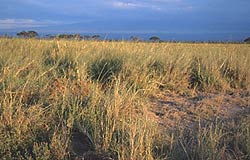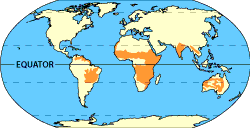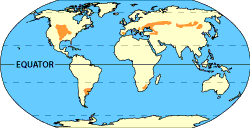Topic Overview: Grasslands
 Grasslands are just that—lands covered with grass. Grasslands are usually warm. They are not as dry as deserts. But they are drier than forests. There are not many trees or shrubs in grasslands. That is because there is not enough water in this biome for them to grow. There are different types of grasslands. They are located in different parts of the world. The climate is different in each type of grassland. Therefore, the plants and animals that can live in each type of grassland are different. Grasslands are just that—lands covered with grass. Grasslands are usually warm. They are not as dry as deserts. But they are drier than forests. There are not many trees or shrubs in grasslands. That is because there is not enough water in this biome for them to grow. There are different types of grasslands. They are located in different parts of the world. The climate is different in each type of grassland. Therefore, the plants and animals that can live in each type of grassland are different.
Berkeley's Biomes group divides the grasslands of the world into two main groups. They are tropical grasslands and temperate grasslands.
Tropical grasslands are also known as savannas. Tropical grasslands can be found in Australia, India, Africa, and South America. They surround tropical forests. Tropical grasslands can also be found in North America. The Everglades in south Florida is a tropical grassland. Tropical grasslands are hot like tropical forests. They do not receive as much rain, though. Tropical grasslands have two seasons. There is a warm and wet summer season. There is also a cooler winter season. Winter is long and dry. Fires burn through grasslands during the dry season.

Most of the plants in tropical grasslands are tall grasses. A few lone trees grow in places where their roots can reach underground water. Animals look for shade under these trees. Large animals like lions, elephants, and zebras live in some tropical grasslands. Birds and snakes live there too.
Temperate grasslands are found in parts of South America, South Africa, Europe, and Asia. They can also be found in North America. The prairie in Kansas is a temperate grassland. Summers in temperate grasslands are very hot. Winters are very cold. Temperate grasslands receive a lot less rain than tropical grasslands.

Temperate grasslands do not have any trees or large shrubs. The only plants that grow there are grasses and some wildflowers. Large animals like deer, wolves, and zebras live in temperate grasslands. Small animals like prairie dogs, rabbits, and mice live there too. Birds, snakes, and insects also live in temperate grasslands.
Photo © 2000-2003 www.clipart.com |











